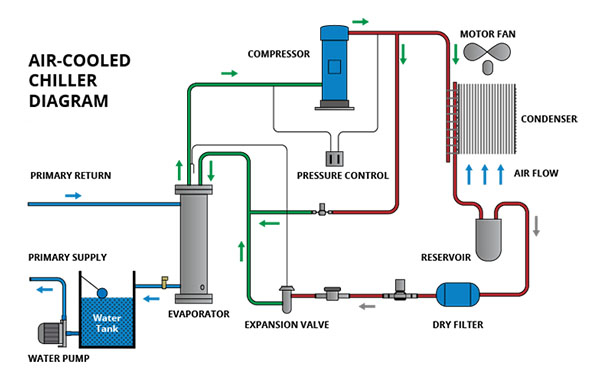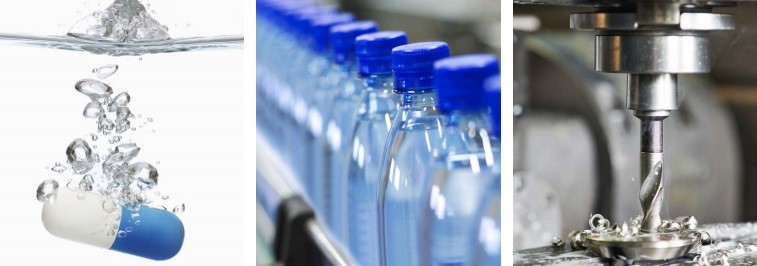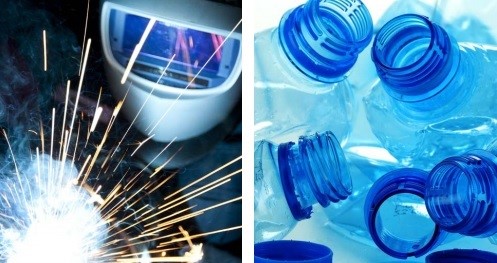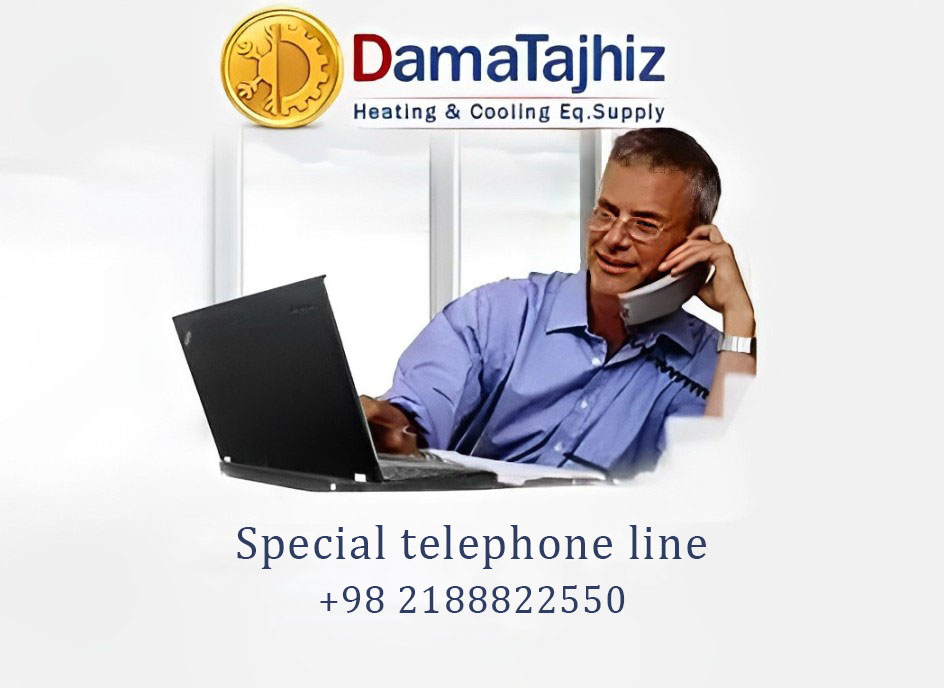Regardless of the desired process or business, an industrial chiller is a piece of refrigeration equipment that removes the heat generated in industrial processes. By performing this function, the equipment's professional career is extended and its production process is maintained. An industrial chiller is a type of refrigeration system that uses components like compressors, condensers, expansion valves, and evaporators as well as refrigerants like Freon gas or even ammonia to continually cool water and provide the necessary cooling in an industrial and process complicated. To lower the temperature, enhance the process, or shorten the working time in industrial and process activities, it circulates in a continuous loop.
Industrial chillers are used in a variety of fields and situations where heat must be removed from a substance that cools goods or machinery. The growing complexity of industrial processes and the initial investments made by industrial units demonstrate that using the best refrigeration equipment with the highest level of accuracy and reliability, zero downtime, and temperature control that is highly reliable 24 hours a day, 365 days a year, is a definite requirement for a manufacturing environment.
In many businesses, temperature control and cooling are provided by industrial chillers. By selecting the ideal industrial chiller for the required industrial application, cooling expenses, downtime, and process performance can all be reduced. Industrial chillers are used by the food and pharmaceutical industries, welding, casting, chemical processes, plastics industries, printing, etc. to create goods, maintain a safe industrial unit temperature, or speed up production.
Tons of refrigeration is used to evaluate an industrial chiller's cooling capacity. Industrial chillers come in a variety of sizes, with portable mini chillers having a capacity of fewer than 3 tons of refrigeration and big, multiple units having a capacity of at least 1000 tons of refrigeration.
Click to view brands, models, and different types, find out the price, and Buy A chiller.

In contrast to commercial chillers or chillers used in air conditioning systems for the most abrasive environments and weather conditions, industrial chillers are designed to withstand continuous use. They are also different from standard chillers used in air conditioning systems that are used in office buildings, residential buildings, etc.
performance of commercial chillers
Condensation or absorption refrigeration cycles are used by industrial chillers to generate cooling. Industrial compression chillers are driven by an electric compressor, whereas industrial absorption chillers use a heat source to initiate the refrigeration cycle. Both of these procedures use the cycle of distillation and vaporization to transfer heat from one location to another, providing the necessary cooling.
The condensed refrigerant gas is cooled to become a liquid during the distillation process using either water or outside air, based on the type of condenser in the chiller structure (air-cooled or water-cooled condenser). The most effective choice for cooling a process is an industrial water chiller because of its high efficiency, but they need a water pump. Despite what might be expected, a cooling structure should be included if water recycling is required. In addition to using outside air to blow on the refrigerant gas cooling air condenser tubes, industrial air chillers also refuse some of the thermal energy and release it into the atmosphere.
Like some of the other compression refrigeration systems, industrial compression chillers have four major parts that each play a crucial part in the cooling process. These chillers are more effective and popular than industrial absorption chillers.
- Compressor
- Condenser
- Expansion valve
- Evaporator
The refrigerant vapour enters a compressor at the start of the cooling procedure. The compressor is the brain of the compression refrigeration device, and electricity powers it. The pressure of the refrigerant rises during this procedure. The refrigerant enters the condenser after leaving the compressor, changing its phase from vapour to liquid condenser while releasing heat (in air chillers, the refrigerant vapour is at a higher temperature than the air passing through the condenser tubes, and in water chillers Also, the refrigerant vapour has a higher temperature compared to the water in the flow inside the condenser tubes). The temperature and pressure of the refrigerant then drop as it enters the expanding valve. After that, the refrigerant travels to the evaporator where it is heated by the fluid that needs to be cooled (such as water, oil, etc.) moving inside the evaporator coils and evaporates. The refrigeration cycle then continues as the refrigerant is re-injected into the condenser.

The above steps are the basis of the refrigeration cycle. But in industrial applications, the cooling process is more complicated and this complexity happens for the following reasons:
- Industrial applications deal with large loads for long periods and therefore require significantly more resources to improve the performance of the desired industrial process.
- In industrial applications, lower temperatures may be required and this requires a large amount of insulation.
- In multi-stage cooling systems, multiple compressors and evaporators may be required.
As a result, other equipment and units are used in industrial chillers, some of which are:
Liquid Receiver: Some units are placed near the condensers and receive and collect the wasted refrigerant.
Suction Trap: The suction trap prevents the refrigerant from entering the compressor and is usually installed near the evaporator and compressor.
Low-Pressure Receiver: The low-pressure receiver helps to separate the liquid from the vapour.
The difference between industrial chillers and commercial chillers or air conditioners
Industrial chillers and chillers used in air conditioning systems have differences in terms of design and performance. The most important differences between industrial chillers and commercial chillers are discussed below.
- Water and cooling circuit
Industrial chillers also have distinct and independent water circulation circuits in addition to independent refrigeration circuits. This matter is crucial if the apparatus fails. Because the system can still function at half its usual capacity even if a circuit fails. In contrast, some commercial air conditioners or chillers lack separate water circuits but do have independent refrigeration circuits. A multi-circuit evaporator is used in air conditioning chillers; if the evaporator malfunctions, the chiller stops operating and the process as a whole cease. Industrial chillers, on the other hand, have independent evaporators, so even if one of them malfunctions, the system can still function at least partially.
- Seasonal temperature fluctuations
Industrial chillers are designed to operate in all weather conditions, while air-conditioning chillers are often inactive in the winter. Because the air conditioning equipment in an air conditioning system does not need to operate due to the lack of cooling in cold weather, unlike industrial processes that remain operational in all seasons of the year regardless of weather conditions.
- Available equipment
Industrial chillers are equipped with a set of pumps, storage tanks, and control systems for regulating the temperature and water flow of the condenser. While most chillers used in air conditioning systems do not have such basic and important equipment. As a result, if there is a need to be equipped with such equipment, the air conditioning chillers have higher installation and commissioning costs because each piece of equipment carries additional purchase and installation costs.
- Industrial applications
Industrial chillers are made in such a way that they provide the cooling needed for industrial and production processes continuously and directly. But air conditioning chillers are designed to adjust the ambient temperature in the desired spaces. Although commercial chillers are also used for some industrial purposes, industrial chillers are preferred over commercial chillers in cases where direct process cooling is required.

All kinds of industrial chillers
Industrial chillers can have a capacity of about 3 to 1000 tons of refrigeration based on the cooling needs of the desired industrial application. Also, based on the type of condenser, the 3 main categories of industrial chillers that are used today are:
- Water-Cooled Chillers
- air-cooled chillers (Air-Cooled Chiller)
- Evaporative Condensed Chillers
The difference between the above chillers is related to the condenser used in their structure. Water and air chillers are the most common chillers used in industrial processes, which are analyzed and compared in the following.
Water chillers
The most common types of water chillers use cooled water in an external cooling tower to cool the refrigerant gas in the condenser. After removing the heat from the refrigerant gas, the refrigerant gas undergoes a phase change and turns into a liquid refrigerant, and circulates again in the chiller refrigeration system.
Advantages of water chillers
- Water chillers have a lower cost than air chillers.
- Water chillers are generally more energy efficient than air chillers.
- Water chillers have quieter and quieter operations compared to air chillers.
- Water chillers are suitable for use in small-scale and large-scale applications.
- The longer useful life of water chillers compared to air chillers
- More accurate heat transfer of water chillers compared to air chillers
Disadvantages of water chillers
- Water chillers sometimes have higher initial and maintenance costs due to additional cooling towers, water tanks, and pumps.
- Since they require a constant source of water for cooling, they may not be suitable for areas with water shortages.
- Water chillers require regular and periodic purification of condenser water to prevent the formation of mineral deposits in the system. (Using a hardener in the water circuit)
- Compared to air chillers, they need more space for installation.
Air chillers
Air chillers use ambient air to remove heat from the refrigerant gas in the condenser, and then this refrigerant condenses and circulates in the system again. In addition, air fans connected to the system help speed up the cooling process. Industrial air chillers are suitable for applications in which the heat output and rejection do not cause a problem because this heat output can transfer a significant amount of heat to the environment.
Advantages of air chillers
- Lower initial costs compared to water chillers
- They do not have water treatment costs and their maintenance and repair costs are lower.
- They have smaller dimensions and require less installation space.
- Air chillers are available for small and large-scale applications based on chiller dimensions and capacity.
- The heat removed from the air chiller can be used in cold seasons to heat the unit, thereby saving money and additional power.
- The initial purchase cost of air chillers is higher than water chillers in the same model and capacity.
Disadvantages of air chillers
- Air chillers have lower efficiency compared to water chillers.
- Air chillers use cooling fans, which produce some noise pollution.
- The expected useful life of air chillers is less than that of water chillers.
- Air chillers transfer heat less accurately.
There are also four subgroups for each of the above industrial chillers:
- Industrial chiller with reciprocating compressor
- Industrial chiller with centrifugal compressor
- Industrial chiller with screw compressor
- Absorption industrial chiller
Reciprocating, centrifugal, and screw chillers are compression chillers whose power is provided by an electric motor (in some cases by a steam turbine or a gas turbine). Absorption chiller also works by a heat source such as steam, hot water, or direct flame and has no moving parts.
Components of industrial chillers
Industrial chillers have many different parts based on their design. Every industrial chiller includes a compressor, condenser, evaporator, pumps, pipelines, expansion valve, possible cooling towers, tanks, filters, fans, etc.
Compressors in industrial chillers
- v Reciprocating compressor
A reciprocating compressor is a compressor that uses pistons connected to a crankshaft. Reciprocating compressors are used to condense a small amount of refrigerant at very high pressure. Reciprocating compressors can have capacities ranging from 3 to 60 horsepower and are often semi-enclosed, which simply means they are repairable.
- v Centrifugal compressor
Centrifugal compressors have few moving parts and this feature makes them a desirable option in the industry. They are also very energy efficient and deliver more refrigerant flow compared to a reciprocating compressor of the same capacity. Centrifugal compressors are more suitable for applications requiring high volumes and low pressure. Centrifugal compressors compress air using centrifugal force. Common capacities of chillers equipped with centrifugal compressors range from 60 to hundreds of tons of refrigeration. Centrifugal compressors are closed and sealed types with magnetic bearings.
- v screw compressor
In the screw compressor, there are two types of spirals (male and female) that are placed together in a fixed body. As the rotor rotates, the gas condenses due to the reduction in the volume of space between the two rotors. These compressors are semi-closed and have a capacity ranging from 40 to 1000 horsepower. There are also single-screw compressors that perform the compression process based on the rotation of a rotating spiral between two-star wheels.
Evaporators in industrial chillers
- v Shell and tube evaporator
Usually, the structure of the shell and tube evaporator is such that the refrigerant flows inside the tubes and the process fluid flows inside the shell. The structure of the pipes can be made of copper, cupronickel, or stainless steel. The shell is also made of materials such as iron, brass, cupronickel, or stainless steel. This type of evaporator has a lower pressure drop compared to soldered plate evaporators and is available in standard structures with up to 500 tons of capacity.
- v Plate evaporators
The biggest advantages of plate evaporators compared to shell and tube evaporators are maximum efficiency, lower costs, and the use of stainless steel and copper in their structure.
Maintenance of industrial chillers
Industrial chillers are designed to operate continuously and at peak load. The principles of maintenance and repairs of industrial chillers, which must be carried out according to a specific order, help ensure the operation of industrial chillers at an optimal efficiency level.
Industrial chillers installation site
Large industrial chillers are generally placed in mechanical equipment rooms that are adjacent to the industrial unit that requires cooling. Some industrial chillers may be placed directly next to the industrial unit, depending on the dimensions of the chiller and compressor, and some may be installed completely outside.
You can also read the article WHAT IS COOLING TOWER for more information.
Applications of industrial chillers
Industrial chillers use the cooling process to remove heat from industrial and process units and are suitable for many industries and applications, including:
- Plastic industries (for example, in injection and impact moulding)
- Food and beverage industry
- baking industry
- Pharmaceutical and chemical industries
- Printing industry
- Composite construction
- Casting
- welding
- Machining and cutting
- laser cut


Final speech
The concentrated collection (DamaTajhiz) (the first and most reputable authority in the nation in the field of building facilities equipment and all air conditioning devices) offers you all varieties of sand filters and hundreds of other products, ensuring the product's originality, a valid warranty, and a fair price. You can also get free guidance from the pros who specialize in heating equipment if you have any questions about selecting and contrasting the brands of this product.
Since 2004, DamaTajhiz has been Iran's first and most well-known specialized organization in the area of air conditioners, air installation equipment, and all equipment for swimming pools, saunas, and jacuzzis. cite this group's era. Calling +98 21 88822550 will connect you with the specialists at DamaTajhiz Engineering and Production Corporation for more information.

We are waiting for your call and look forward to meeting you at the DAMATAJHIZ group
By sharing the above article on social networks, let your friends know about its important content.
|
|

